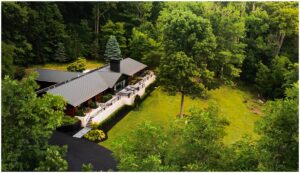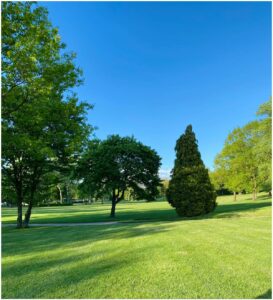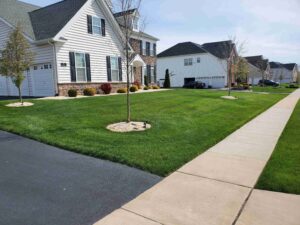Lawn care in Bucks County comes with its challenges: changing seasons, unpredictable weather, and specific soil conditions all play a role. Creating and maintaining a lush, even lawn means staying proactive throughout the year with thoughtful treatments and expert support.
One of the biggest game-changers? Seeding. Done right, seeding can revive thin grass, repair bare spots, and create a lawn that’s healthier, more resilient, and better able to fend off weeds and pests. Done wrong, and you’ve wasted time, money, and effort.
Whether you’re starting fresh or giving your yard a boost, here are 10 expert-approved tips to get seeding right in Bucks County.
1. Start with a Lawn Assessment
Before you run to the store for seed, it’s important to understand your lawn’s unique needs. Ask yourself:
- Are the bare patches due to poor soil, foot traffic, pests, or shade?
- Do weeds seem to be taking over?
- Is your grass thinning evenly or in certain areas?
A great tip if you’re unsure of where to start is to get your soil tested. In Bucks County, soil often skews acidic and compacted, especially with our clay-heavy base. Knowing your soil’s pH and nutrient levels will help guide what amendments or treatments you’ll need for success.
How do I know if I should overseed or reseed?
Overseeding is ideal when your lawn is generally healthy but could use a boost in thickness. It involves spreading new seed over existing grass to improve density.
Reseeding, on the other hand, is more aggressive and used for large, bare, or damaged areas that need to be rebuilt from the ground up.
2. Time Your Seeding Wisely
Great results depend on great timing. And in Bucks County, fall is the best season to seed.
- Fall (September–early October) offers the perfect combo: warm soil, cooler air temps, and fewer weeds competing with seedlings.
- Spring is a possible second choice, but you’ll face more weed pressure and the risk of hot weather before your new grass establishes.
Waiting too long in the fall can expose new grass to frost before it’s ready, so mark your calendar and don’t delay.
3. Choose the Right Grass Seed
Not all grasses thrive in Bucks County’s four-season climate. For best results, choose a cool-season blend that combines durability, fast germination, and seasonal flexibility.
- Kentucky bluegrass: Deep green and dense, but slow to germinate.
- Perennial ryegrass: Fast sprouting and great for high-traffic areas.
- Fine fescues: Tolerant of shade and lower-maintenance.
Should I choose one type or a mix?
A blend is usually best. Different grasses perform better in different conditions, so mixing ensures year-round resilience.
4. Prep Your Soil Like a Pro
Proper soil prep is what separates successful seeding from wasted effort. Even the best seed won’t grow without strong seed-to-soil contact and the right conditions underneath.
Here’s how to get your lawn ready:
- Mow existing grass to about 2 inches.
- Rake away debris, leaves, and clippings.
- Loosen the top layer of soil with a rake or light tiller.
- For compacted soil (common in Bucks County), core aeration can help air, water, and nutrients reach deeper.
How do you prep soil before seeding?
Make sure the surface is loose, clean, and slightly textured, as this helps seeds settle in and absorb moisture.
Can I just throw grass seed down on dirt?
Technically, yes—but it’s not ideal. Grass seed left on hard or bare dirt is unlikely to root well and can easily wash away. Prepping the soil by loosening it and adding a light top dressing gives your seed the best shot at germination.
5. Tackle Bare Spots Strategically
Bare spots are more than just an eyesore. They’re an open invitation for weeds, pests, and soil erosion. The good news? With the right approach, they’re easy to fix. Sprinkling grass seed on bare dirt might sound simple, but without loosening the soil and ensuring good seed-to-soil contact, it likely won’t take. Hard, compacted dirt doesn’t hold moisture well, and your seed may wash away before it ever roots.
Here’s the best way to repair them:
- Loosen the soil 1–2 inches deep to promote good seed-to-soil contact.
- Add a thin layer of compost or enriched topsoil if the area is dry or depleted.
- Spread grass seed evenly over the area.
- Lightly rake to blend the seed into the top layer of soil and don’t bury it too deep.
- Water gently and consistently until the new grass is established.
Want to encourage grass to spread naturally into bare spots? Keep your lawn healthy with regular mowing at the right height, proper watering, and fertilization. Thick, healthy grass will eventually begin to fill in minor gaps on its own.
When’s the best time to repair bare spots in Bucks County?
Fall is ideal since cooler temperatures and warm soil give seeds the best chance to root before winter sets in. Spring is your second-best window, though you may need to manage more weed competition and plan for summer watering.
6. Water for Germination, Then Growth
Seeding success is all about consistent moisture.
- During germination: Lightly water 1–2 times per day to keep the top inch of soil moist.
- After germination: Switch to deeper, less frequent watering to promote strong roots.
Avoid heavy watering or a strong spray setting as too much pressure can wash your seed away before it gets a chance to grow.
How long until I see results?
Ryegrass may germinate in 5–7 days. Kentucky bluegrass takes 14–21 days. But all new grass needs consistent moisture for several weeks to fully establish.
7. Feed Your New Grass
Fertilizer isn’t just for established lawns but can also help new grass grow strong from the start. Whether you’re seeding in spring or fall, providing the right nutrients early on can speed up germination, support root development, and help your lawn grow in thicker and healthier.
Starter fertilizers are specifically designed for new grass. They typically contain higher levels of phosphorus (the middle number in the N-P-K ratio) to encourage strong root growth, along with nitrogen for vibrant color and potassium for overall plant health.
What to Look for in a Fertilizer (and What to Avoid)
Choose a starter fertilizer with a balanced ratio, something like 10-10-10, and make sure it’s labeled for new lawns or overseeding. These blends deliver the essential nutrients young grass needs without overloading it.
Apply the fertilizer at the same time you seed or shortly after. This gives new roots immediate access to nutrients when they need them most. If you wait too long, you risk missing that critical window for early development.
Concerned about harming new grass?
Don’t be. As long as you use a fertilizer intended for seedlings and follow the label instructions, it won’t damage your lawn. In fact, skipping fertilizer altogether can slow growth or lead to weak, patchy results. The key is to avoid high-nitrogen blends designed for mature grass, which can be too harsh for tender new shoots.
Fall is one of the best times to fertilize in Bucks County. Cooler temperatures and warm soil conditions create the perfect environment for root development before winter, so your lawn comes back stronger and greener in the spring.
And finally, don’t forget to water. Fertilizer needs to be activated by moisture to soak into the soil and reach the roots, so give your lawn a good drink after applying.
8. Mow at the Right Time (and Height)
Hold off on mowing until the new grass reaches about 3 inches tall. Mowing too early can damage fragile roots.
When you do mow:
- Use sharp blades for a clean cut.
- Follow the one-third rule: never cut more than a third of the grass blade height at once.
- Avoid bagging the clippings and let them mulch back into the soil for a natural nutrients boost.
9. Keep Weeds in Check (Without Harming New Grass)
Weeds love bare soil and stressed lawns, which is why weed control is especially important after seeding. But timing and method matter.
Skip harsh herbicides for the first 6–8 weeks after planting new seed. Many weed killers can damage young grass or prevent seeds from germinating altogether. If your lawn is newly seeded, focus on building turf density first. A thick, healthy lawn is the best long-term defense against weeds.
What kills weeds without harming grass?
Once your lawn is established, look for selective post-emergent herbicides labeled safe for lawns. These are designed to target broadleaf weeds like dandelions or clover without harming your turfgrass, but always check that it’s safe for your specific grass type.
For small areas or early-stage infestations, hand-pulling weeds is absolutely worth the effort. It’s the safest method for new lawns and can prevent weeds from spreading if done consistently. Just be sure to remove the roots, not just the visible growth.
When’s the best time to tackle weeds in Bucks County?
Early fall is ideal. The weather is cooler, the soil is still warm, and many weeds are actively growing, making them more vulnerable to treatment.
The goal isn’t perfection overnight, but it is all about building a healthier lawn season by season, so weeds naturally have fewer places to thrive.
10. Know When to Call in The Pros
Even with the right tools and timing, lawn care in Bucks County can be unpredictable. From clay-heavy soil and mature trees casting shade to drainage issues and shifting temperatures, every yard comes with its own challenges.
That’s where expert guidance can make all the difference.
Working with a local lawn care team like Kelly Grow means you don’t have to second-guess things like:
- Which seed blend works best for your sun, shade, and soil?
- When to seed, aerate, or fertilize for our regional climate?
- How to prep your property without overdoing or missing a step?
We handle the details so your lawn gets what it needs without the trial and error. Whether you’re reseeding bare patches, thickening up a tired lawn, or starting from scratch, we’ll help you create a lawn you’ll love to live in.
Final Word: Set Your Lawn Up for Long-Term Success
Perfect lawns don’t happen overnight, but smart seeding is the first step. From choosing the right blend to timing, prep, and care, every piece plays a role in creating a yard that thrives year after year.
When you invest in your lawn’s foundation, you get more than great curb appeal. You get an outdoor space that’s stronger, healthier, and easier to maintain season after season.
Need help getting started?
The Kelly Grow team is here to take the guesswork out of lawn care. From expert lawn assessments to professional seeding and soil prep, we’ll help you build a lawn you’ll love to live in, season after season.
Contact us today to schedule your seeding consultation and let’s grow something great.




